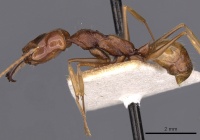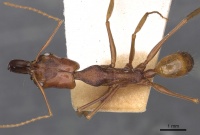Odontomachus mayi
| Odontomachus mayi | |
|---|---|

| |
| Scientific classification | |
| Kingdom: | Animalia |
| Phylum: | Arthropoda |
| Class: | Insecta |
| Order: | Hymenoptera |
| Family: | Formicidae |
| Subfamily: | Ponerinae |
| Tribe: | Ponerini |
| Genus: | Odontomachus |
| Species: | O. mayi |
| Binomial name | |
| Odontomachus mayi Mann, 1912 | |
| At a Glance | • Ant garden |
Identification
A member of the Odontomachus haematodus group.
Keys including this Species
Distribution
Latitudinal Distribution Pattern
Latitudinal Range: 5.25° to -12.497473°.
| North Temperate |
North Subtropical |
Tropical | South Subtropical |
South Temperate |
- Source: AntMaps
Distribution based on Regional Taxon Lists
Neotropical Region: Brazil (type locality), Ecuador, French Guiana, Guyana, Suriname.
Distribution based on AntMaps
Distribution based on AntWeb specimens
Check data from AntWeb
Countries Occupied
| Number of countries occupied by this species based on AntWiki Regional Taxon Lists. In general, fewer countries occupied indicates a narrower range, while more countries indicates a more widespread species. |

|
Estimated Abundance
| Relative abundance based on number of AntMaps records per species (this species within the purple bar). Fewer records (to the left) indicates a less abundant/encountered species while more records (to the right) indicates more abundant/encountered species. |

|
Biology
Ant Gardens
This species is known to form ant gardens (i.e., they are able to initiate ant gardens or are restricted to ant gardens) (Campbell et al., 2022; Dejean et al., 2000; Mann, 1912; Marini Filho, 1999; Orivel & Leroy, 2011; Orivel et al., 1998 (noted as ant-garden initiator)).
Association with Other Organisms
 Explore: Show all Associate data or Search these data. See also a list of all data tables or learn how data is managed.
Explore: Show all Associate data or Search these data. See also a list of all data tables or learn how data is managed.
- This species is a host for the eucharitid wasp Kapala sp. (a parasitoid) (Quevillon, 2018) (multiple encounter modes; direct transmission; transmission outside nest).
Castes
Nomenclature
The following information is derived from Barry Bolton's Online Catalogue of the Ants of the World.
- mayi. Odontomachus affinis subsp. mayi Mann, 1912: 39 (w.) BRAZIL (Rondônia)).
- Type-material: syntype workers (number not stated, “numerous”).
- Type-locality: Brazil: Mato Grosso (now Rondônia), Madeira Mamoré Railroad Company Camp no. 41, 306 km. from San Antonio, viii.1911 (W.M. Mann).
- Type-depository: MCZC (probably also in AMNH, LACM).
- [Misspelled as mayri by Wheeler, W.M. 1942: 156.]
- Subspecies of affinis: Mann, 1916: 418; Borgmeier, 1923: 77; Wheeler, W.M. 1942: 156.
- Status as species: Kempf, 1972a: 7, 172; Brown, 1976a: 104, 124; Bolton, 1995b: 296; Rodriguez, J. 2008: 165; Feitosa, 2015c: 99; Fernández & Guerrero, 2019: 539.
- Distribution: Brazil, Colombia, French Guiana, Guyana.
Description
References
- Albuquerque, E., Prado, L., Andrade-Silva, J., Siqueira, E., Sampaio, K., Alves, D., Brandão, C., Andrade, P., Feitosa, R., Koch, E., Delabie, J., Fernandes, I., Baccaro, F., Souza, J., Almeida, R., Silva, R. 2021. Ants of the State of Pará, Brazil: a historical and comprehensive dataset of a key biodiversity hotspot in the Amazon Basin. Zootaxa 5001, 1–83 (doi:10.11646/zootaxa.5001.1.1).
- Brown, W. L., Jr. 1976c. Contributions toward a reclassification of the Formicidae. Part VI. Ponerinae, tribe Ponerini, subtribe Odontomachiti. Section A. Introduction, subtribal characters. Genus Odontomachus. Stud. Entomol. 19: 67-171 (page 124, Raised to species)
- Camargo, K.S. de. 2011. Composicao e diversidade de "Poneromorfas" (Hymenoptera, Formicidae) em duas fitofisionomias de cerrado e padroes de distribuicao de "Poneromorfas", Pseudomyrmecinae e Cephalotini (Myrmicinae) para o Brasil. Thesis, Universidade de Brasilia.
- Campbell, L.C.E., Kiers, E.T., Chomicki, G. 2022. The evolution of plant cultivation by ants. Trends in Plant Science (doi:10.1016/j.tplants.2022.09.005).
- Dejean, A., Corbara, B., Orivel, J., Snelling, R.R., Delabie, J.H.C., Belin-Depoux, M. 2000. The importance of ant gardens in the pioneer vegetal formations of French Guiana. Sociobiology 35: 425-439.
- Franco, W., Ladino, N., Delabie, J.H.C., Dejean, A., Orivel, J., Fichaux, M., Groc, S., Leponce, M., Feitosa, R.M. 2019. First checklist of the ants (Hymenoptera: Formicidae) of French Guiana. Zootaxa 4674, 509–543 (doi:10.11646/zootaxa.4674.5.2).
- Kempf, W. W. 1972b. Catálogo abreviado das formigas da regia~o Neotropical. Stud. Entomol. 15: 3-344 (page 172, Raised to species)
- Lenoir, A., P. D’Ettorre, P., Errard, C., Hefetz, A. 2001. Chemical ecology and social parasitism in ants. Annual Review of Entomology 46: 573–599.
- Mann, W. M. 1912. Parabiosis in Brazilian ants. Psyche (Camb.) 19: 36-41 (page 39, worker described)
- Marini-Filho, O.J. 1999. Distribution, composition, and dispersal of ant gardens and tending ants in three kinds of central Amazonian habitats. Tropical Zoology 12: 289-296.
- Orivel, J., Dejean, A. & Errard, C. 1998. Active role of two ponerine ants in the elaboration of ant gardens. Biotropica 30: 487-491.
- Orivel, J., Leroy, C. 2011. The diversity and ecology of ant gardens (Hymenoptera: Formicidae; Spermatophyta: Angiospermae). Myrmecological News 14: 73-85.
References based on Global Ant Biodiversity Informatics
- Astruc C., J. F. Julien, C. Errard, and A. Lenoir. 2004. Phylogeny of ants based on morphology and DNA sequence data. Molecular Phylogenetics and Evolution 31: 880-893.
- Brown W. L., Jr. 1976. Contributions toward a reclassification of the Formicidae. Part VI. Ponerinae, tribe Ponerini, subtribe Odontomachiti. Section A. Introduction, subtribal characters. Genus Odontomachus. Stud. Entomol. 19: 67-171.
- Dejean A., B. Corbara, J. Orivel, R. R. Snelling, J. H. C. Delabie, and M. Belin-Depoux. 2000. The importance of ant gardens in the pioneer vegetal formations of French Guiana (Hymenoptera: Formicidae). Sociobiology 35(3): 425-439.
- Fernández F., and T. M. Arias-Penna. 2008. Las hormigas cazadoras en la región Neotropical. Pp. 3-39 in: Jiménez, E.; Fernández, F.; Arias, T.M.; Lozano-Zambrano, F. H. (eds.) 2008. Sistemática, biogeografía y conservación de las hormigas cazadoras de Colombia. Bogotá: Instituto de Investigación de Recursos Biológicos Alexander von Humboldt, xiv + 609 pp.
- Fernández, F. and S. Sendoya. 2004. Lista de las hormigas neotropicales. Biota Colombiana Volume 5, Number 1.
- Franco W., N. Ladino, J. H. C. Delabie, A. Dejean, J. Orivel, M. Fichaux, S. Groc, M. Leponce, and R. M. Feitosa. 2019. First checklist of the ants (Hymenoptera: Formicidae) of French Guiana. Zootaxa 4674(5): 509-543.
- Gibernau M., J. Orivel, J. H. C. Delabie, D. Barabe, and A. Dejean. 2007. An asymmetrical relationship between an arboreal ponerine ant and a trash-basket epiphyte (Araceae). Biological Journal of the Linnean Society 91: 341-346.
- Lozano-Zambrano F. H., E. Jimenez, T. M. Arias-Penna, A. M. Arcila, J. Rodriguez, and D. P. Ramirez. 2008. Biogeografía de las hormigas cazadoras de Colombia. Pp. 349-406. in: Jiménez, E.; Fernández, F.; Arias, T.M.; Lozano-Zambrano, F. H. (eds.) 2008. Sistemática, biogeografía y conservación de las hormigas cazadoras de Colombia. Bogotá: Instituto de Investigación de Recursos Biológicos Alexander von Humboldt, xiv + 609 pp.
- Orivel, J., A. Dejean and C. Errard. 1998. Active Role of Two Ponerine Ants in the Elaboration of Ant Gardens. Biotropica 30(3):487-491.

